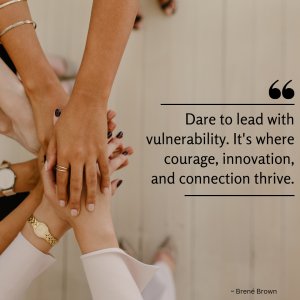The start of a new year is often a time for reflection and setting intentions. For government leaders, it’s an opportunity to not only assess past performance but also to inspire teams to reach new heights. But how do we foster a culture that encourages innovation and risk-taking in the often risk-averse world of government? Consider that the answer might lie in embracing vulnerability.
Why Vulnerability Matters in Government

Brené Brown’s research on vulnerability has resonated deeply with leaders across sectors, and its applications in government are particularly relevant. In government, where accountability and transparency are paramount, vulnerability can seem counterintuitive. However, creating a space where employees feel safe to speak up, share ideas, and admit challenges can lead to:
- Increased Trust: When leaders show vulnerability, it fosters trust among team members. This leads to better communication and collaboration.
- Enhanced Innovation: A culture that embraces vulnerability encourages employees to think outside the box and propose new solutions without fear of failure.
- Improved Problem-Solving: Openly acknowledging challenges allows for more effective problem-solving as teams can leverage diverse perspectives and expertise.
Vulnerability in Action: A Government Example
Imagine a project team working on a critical IT modernization initiative. By fostering a culture of vulnerability, the team leader can create an environment where:
- Roadblocks are identified early on: Team members feel comfortable escalating challenges, preventing costly delays.
- Diverse perspectives are valued: Individuals with varying levels of technical expertise feel empowered to contribute ideas.
- Learning from setbacks is encouraged: Mistakes are seen as opportunities for growth, not punishment.
Practical Steps for Government Leaders
Here are some ways government leaders can cultivate vulnerability within their teams:
- Start with yourself: Model vulnerability by openly acknowledging your own challenges and seeking input from your team.
- Create safe spaces: Encourage open communication and active listening during meetings and team interactions.
- Promote a growth mindset: Frame challenges as learning opportunities and celebrate both successes and failures.
- Recognize and address fear: Acknowledge that vulnerability can be uncomfortable and address any underlying fears within the team.
Call to Action:
Being vulnerable is hard and yet most of the time when I have the courage to exercise it, I find that individuals drop their “guard” and I’m able to have a more authentic conversation that leads to a more robust solution or relationship (maybe both!).
As government leaders, we have a responsibility to create a work environment where employees feel valued, supported, and empowered. By embracing vulnerability, we can unlock the potential of our teams and drive positive change for the citizens we serve. If not you, then who? What are you willing to do to foster vulnerability within your team or project this year?

Sally is a seasoned federal government professional with experience in strategic communication, program development, holistic coaching, and cultivating a thriving workplace environment. She is passionate about aligning organizational goals with employee satisfaction, productivity, and retention. Her holistic approach to leadership emphasizes the importance of both personal and professional growth within the public sector.




Leave a Reply
You must be logged in to post a comment.